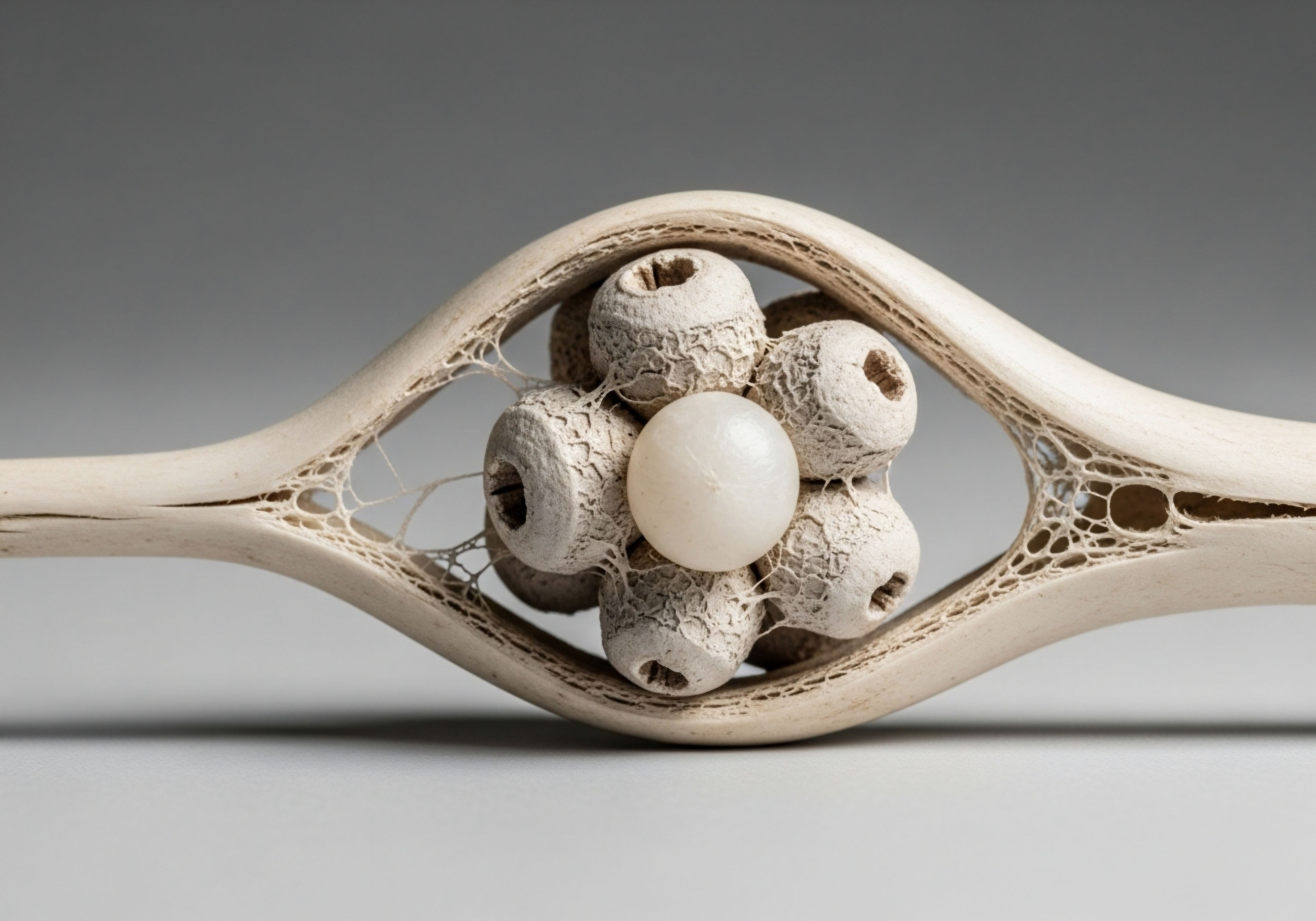

Fundamentals
The persistent warmth, itching, and swelling at an injection site can feel like a frustrating betrayal. You have embarked on a path of hormonal optimization to reclaim your vitality, yet your body seems to be fighting the very protocol designed to help it.
This localized reaction is a deeply personal experience, a physical manifestation of a complex biological conversation happening just beneath your skin. It is a direct signal from your body’s innate defense systems, and understanding its language is the first step toward resolving the conflict.
Each injection introduces a solution ∞ be it testosterone suspended in a carrier oil or a therapeutic peptide in a sterile liquid ∞ that the body must recognize, process, and absorb. The response at the site of this introduction is a carefully orchestrated event managed by your local immune cells.
These cells act as the first line of defense, a vigilant security team patrolling your tissues. When the needle breaks the skin and the fluid is introduced, this team immediately investigates the disturbance. Their primary goal is containment and assessment. This process involves the release of signaling molecules, known as cytokines and histamines, which create a localized inflammatory response.
This response is characterized by increased blood flow to the area, causing redness and warmth. The blood vessels become slightly more permeable, allowing specialized immune cells to arrive at the scene, which results in swelling. This entire cascade is a normal and protective mechanism. It is your body’s way of ensuring the introduced substance is safe and properly integrated.
The reaction at an injection site is your body’s intelligent, protective immune system initiating a dialogue with the therapeutic substance you’ve introduced.

The Underlying Systemic Influence
The intensity and persistence of this local reaction, however, are often dictated by factors far beyond the injection site itself. Your body’s overall state of readiness, its systemic inflammatory baseline, sets the tone for this local immune event. Consider your immune system as a national security network.
If the entire network is on high alert due to chronic stress, metabolic imbalance, or underlying hormonal dysregulation, then even a small, localized event will trigger a disproportionately strong response. A body already coping with systemic inflammation is primed to overreact. The security team at the injection site is jumpy, responding with excessive force because it is receiving constant alerts from the central command.
This is where the journey of hormonal health becomes profoundly interconnected. The very reason you may be using testosterone or peptide therapies ∞ to address symptoms of hormonal decline or metabolic dysfunction ∞ is often linked to a state of low-grade, chronic inflammation.
This systemic condition, sometimes referred to as “inflammaging,” means your immune cells are already activated and more sensitive to triggers. Therefore, the persistent lump or prolonged redness you experience is a reflection of this pre-existing internal environment.
Mitigating these reactions effectively requires a dual focus ∞ refining the local event of the injection itself and, more importantly, addressing the systemic inflammatory state that amplifies the response. By viewing the injection site reaction through this lens, it transforms from a simple annoyance into a valuable piece of biofeedback, offering insights into your body’s overall wellness and the progress of your health journey.


Intermediate
Understanding the clinical strategies for managing injection site reactions requires a detailed examination of the injection event itself, from the composition of the fluid to the physical technique of its administration. The substances being injected are rarely just the active hormone or peptide. They are complex formulations, and each component can potentially initiate a local immune response. A comprehensive approach involves identifying the potential triggers and implementing precise techniques to minimize tissue disruption and immune activation.

Deconstructing the Injected Solution
The therapeutic compounds used in hormonal optimization protocols are delivered in a vehicle designed to ensure stability and proper absorption. Each part of this solution can be a variable in the equation of inflammation.
- The Active Compound ∞ The therapeutic agent itself, whether it is a testosterone ester (like cypionate or enanthate) or a specific peptide (like Sermorelin or BPC-157), is a foreign molecule that the immune system must assess. Peptides, being protein fragments, can sometimes directly engage with immune cell receptors, causing a localized release of histamine from mast cells.
- The Carrier Oil ∞ Testosterone is a lipophilic (fat-soluble) hormone, so it must be dissolved in a carrier oil for intramuscular injection. Common carrier oils include cottonseed, sesame, or grapeseed oil. While these are generally well-tolerated, an individual can have a sensitivity to a specific oil, leading to a more pronounced inflammatory reaction. The volume and viscosity of the oil also play a role; a larger volume of thick oil can create a depot that the body works harder to break down, prolonging the inflammatory phase.
- Excipients and Preservatives ∞ To ensure sterility and stability, injectable solutions contain additional inactive ingredients, or excipients. A common preservative is benzyl alcohol, which can be an irritant for some individuals. Other substances like buffers, which maintain the pH of the solution, can also contribute to localized irritation if they are not biocompatible with the subcutaneous or muscle tissue.

What Are the Best Injection Techniques to Minimize Reactions?
The physical act of injection is a controlled form of tissue trauma. Proper technique is paramount to minimizing this trauma and reducing the subsequent inflammatory response. Several factors must be considered to optimize the administration process.

Table of Injection Technique Considerations
| Technique Element | Clinical Rationale and Best Practice |
|---|---|
| Injection Depth (IM vs. SubQ) |
Intramuscular (IM) injections, common for oil-based testosterone, deliver the solution deep into vascular muscle tissue for steady absorption. Subcutaneous (SubQ) injections, used for most peptides and sometimes for testosterone, deliver the solution into the fatty layer beneath the skin. SubQ tissue has more immune surveillance cells, like mast cells, which can lead to more frequent but typically milder surface reactions like itching and redness. Switching from SubQ to IM for a particularly reactive peptide may bypass some of this initial immune surveillance. |
| Needle Gauge and Length |
Using the smallest appropriate gauge (diameter) needle for the viscosity of the solution minimizes the puncture wound. For SubQ injections, a 28-31 gauge needle is typical. For IM testosterone, a 23-25 gauge needle is often required for the oil. Needle length must be sufficient to reach the target tissue ∞ SubQ (1/2″ to 5/8″) or IM (1″ to 1.5″) ∞ without going past it. |
| Injection Site Rotation |
Consistently using the same injection site creates a state of chronic local inflammation. The immune cells in that area remain activated, and scar tissue (fibrosis) can develop, impeding absorption and worsening reactions. A systematic rotation schedule (e.g. different quadrants of the abdomen for SubQ, alternating glutes or deltoids for IM) allows the local tissue environment to fully recover before another injection. |
| Injection Speed and Volume |
Injecting the solution slowly and steadily prevents rapid, forceful expansion of the tissue, which is a significant inflammatory trigger. This is particularly important for larger volumes. When possible, splitting a larger dose into two smaller injections at different sites can substantially reduce the inflammatory burden at any single location. |
Precise injection technique is a clinical skill that minimizes tissue trauma and reduces the magnitude of the initial inflammatory signal.

Immediate Management Protocols
Even with perfect technique, some degree of reaction can occur. Simple, targeted interventions can help manage the symptoms and calm the local inflammatory cascade.

Table of Post-Injection Management Strategies
| Strategy | Mechanism of Action | Application Guidelines |
|---|---|---|
| Cold Compress |
Causes local vasoconstriction (narrowing of blood vessels), which reduces blood flow to the area. This limits the arrival of inflammatory cells and fluid, thereby decreasing swelling and redness. It also numbs local nerve endings, providing pain relief. |
Apply for 15-20 minutes within the first few hours after the injection. Do not apply ice directly to the skin; use a cloth barrier. |
| Warm Compress |
Causes local vasodilation (widening of blood vessels), which increases circulation. This helps disperse the injected fluid and inflammatory byproducts, promoting healing and absorption. It is particularly useful for resolving firm lumps (nodules) that persist after the initial inflammation has subsided. |
Apply for 15-20 minutes, typically starting 24 hours after the injection. Should not be used during the acute swelling phase. |
| Topical Antihistamines or Arnica |
Topical antihistamine creams can block local histamine receptors, directly reducing itching and swelling. Arnica montana is a homeopathic preparation thought to reduce bruising and inflammation. |
Apply a thin layer to the affected area as needed, ensuring the skin is not broken. |
| Systemic Antihistamines |
For more significant itching or pseudo-allergic reactions, an over-the-counter oral antihistamine (e.g. Cetirizine, Loratadine) can be taken 30-60 minutes prior to injection to systemically block histamine release. |
Use as a preventative measure for individuals who consistently experience significant itching with specific peptides or formulations. |
By systematically addressing the components of the injected solution and mastering the physical act of administration, you can significantly reduce the incidence and severity of local inflammatory reactions. These intermediate strategies empower you to take direct control over the variables of the therapeutic process, turning a challenging side effect into a manageable aspect of your wellness protocol.


Academic
A sophisticated clinical approach to mitigating persistent injection site inflammation requires moving beyond mechanical techniques and topical remedies to interrogate the underlying immunobiology. The reaction observed at the skin or in the muscle is the endpoint of a complex dialogue between the injected formulation and the host’s immune system.
This dialogue is profoundly influenced by the individual’s systemic inflammatory status, which is itself modulated by the endocrine system. The most persistent and challenging reactions often arise from a hyper-reactive immune terrain, where specific cellular pathways are primed for an exaggerated response. Understanding these pathways is the key to developing truly effective, personalized mitigation strategies.

The Cellular Basis of Injection Site Reactions
The subcutaneous tissue is not a passive storage depot; it is a dynamic immunological organ. It is densely populated with resident immune cells, most notably mast cells, which are key initiators of the local inflammatory cascade.
While classical allergic reactions involve the cross-linking of IgE antibodies on the mast cell surface, many reactions to therapeutic injectables, especially peptides, occur through IgE-independent pathways. A critical receptor in this process is the Mas-related G protein-coupled receptor X2 (MRGPRX2).
This receptor is highly expressed on cutaneous mast cells and functions as a pattern recognition receptor for a wide variety of molecules, including certain peptides and pharmaceutical excipients. Activation of MRGPRX2 triggers rapid mast cell degranulation, releasing a potent cocktail of pre-formed inflammatory mediators:
- Histamine ∞ Increases vascular permeability, leading to edema (swelling) and erythema (redness), and stimulates nerve endings, causing itching and pain.
- Tryptase and Chymase ∞ Proteases that can contribute to tissue remodeling and activate other pro-inflammatory pathways.
- Tumor Necrosis Factor-alpha (TNF-α) ∞ A pro-inflammatory cytokine that is stored in mast cell granules for rapid release, amplifying the local inflammatory signal and recruiting other immune cells.
This MRGPRX2-mediated activation explains the phenomenon of “pseudo-allergic” reactions, where individuals experience allergy-like symptoms without the presence of specific IgE antibodies. It is a direct, non-allergic pharmacological activation of a primary immune defense pathway. The density of these mast cells and the expression level of MRGPRX2 can vary between individuals, providing a biological basis for differing sensitivities to the same compound.
Persistent injection site reactions often reflect a hyper-responsive immune system where local mast cells are triggered through specific, non-allergic cellular receptors.

How Does the Endocrine System Modulate Local Immunity?
The endocrine system and the immune system are intricately linked in a bidirectional communication network. Hormones function as powerful modulators of immune cell activity, and an individual’s baseline hormonal status can therefore determine the reactivity of the immune cells at an injection site.
A state of hormonal imbalance, such as that seen in hypogonadism or menopause, is often a pro-inflammatory condition. For instance, testosterone generally has immunosuppressive and anti-inflammatory effects, while certain estrogen metabolites can be pro-inflammatory. A low testosterone-to-estrogen ratio can contribute to a state of systemic, low-grade inflammation, effectively lowering the activation threshold for immune cells like mast cells.
This creates a challenging feedback loop ∞ the very condition being treated with hormone therapy (hormonal imbalance) is what primes the body for an adverse reaction to the treatment. The immune system, already dysregulated by an imbalanced hormonal milieu, perceives the therapeutic injection not as a corrective measure but as another inflammatory insult.
This systemic “inflammaging” means that the local mast cells and macrophages at the injection site are already on high alert, with upregulated expression of inflammatory receptors and a greater store of pro-inflammatory mediators ready for release. Consequently, a stimulus that might cause a mild, transient reaction in a hormonally balanced individual can provoke a persistent, painful nodule in someone with an underlying pro-inflammatory state.

Advanced Clinical and Formulation Strategies
Given this complex interplay, advanced strategies must address both the local trigger and the systemic environment.
- Formulation Optimization ∞ The choice of carrier oil and excipients becomes a critical variable. For highly sensitive individuals, compounding pharmacies can prepare testosterone in alternative carrier oils (e.g. grapeseed, olive) to identify a less immunogenic vehicle. Similarly, requesting formulations with minimal or no benzyl alcohol can reduce a known source of irritation. The concentration of the drug itself can be adjusted; a lower concentration in a larger volume, or splitting doses, reduces the bolus of active agent presented to local immune cells at any one time.
- Targeted Immunomodulation ∞ For persistent pseudo-allergic reactions mediated by mast cells, pre-medication with a combination of H1 and H2 antihistamines can block the downstream effects of histamine release. In more severe cases, mast cell stabilizers like cromolyn sodium (though not typically used in this context) illustrate the principle of preventing degranulation at its source. Understanding the specific cytokine profile of the reaction (e.g. high TNF-α) opens future possibilities for targeted local therapies.
- Systemic Inflammatory Management ∞ The most sophisticated and durable strategy involves lowering the body’s systemic inflammatory baseline. This is achieved through the primary goal of the therapy itself ∞ restoring hormonal balance. As testosterone levels normalize and metabolic health improves, the systemic pro-inflammatory signaling decreases. This, in turn, “calms” the peripheral immune cells, making them less likely to overreact to the local stimulus of an injection. This approach also incorporates adjunctive lifestyle and nutritional protocols known to reduce inflammation, such as a diet low in processed foods and rich in omega-3 fatty acids, along with stress management techniques to lower cortisol, another potent modulator of immune function.
Ultimately, resolving persistent injection site inflammation is a process of biological diplomacy. It requires a deep understanding of the cellular players, the modulating influence of the systemic hormonal environment, and the precise chemical nature of the therapeutic intervention. By addressing all three facets, the clinician can transform a reactive and painful experience into a well-tolerated and effective component of a patient’s journey toward reclaimed health.

References
- Sprague, D. L. & Phillips, E. J. “Excipients in Biologics ∞ Importance of Clinical Awareness.” PLoS ONE, vol. 15, no. 6, 2020, e0234589.
- Stone, C. A. Jr. et al. “Hidden Dangers ∞ Recognizing Excipients as Potential Causes of Drug and Vaccine Hypersensitivity Reactions.” The Journal of Allergy and Clinical Immunology ∞ In Practice, vol. 9, no. 4, 2021, pp. 1533-1543.
- Al-Ghadban, S. et al. “Mast Cells as Sources of Cytokines, Chemokines and Growth Factors.” Journal of Histochemistry & Cytochemistry, vol. 67, no. 8, 2019, pp. 551-577.
- Babizhayev, M. A. et al. “Activation of Mast Cells by Neuropeptides ∞ The Role of Pro-Inflammatory and Anti-Inflammatory Cytokines.” International Journal of Molecular Sciences, vol. 22, no. 11, 2021, p. 6079.
- Klose, C. et al. “Cytokines Stimulated by IL-33 in Human Skin Mast Cells ∞ Involvement of NF-κB and p38 at Distinct Levels and Potent Co-Operation with FcεRI and MRGPRX2.” International Journal of Molecular Sciences, vol. 22, no. 16, 2021, p. 8976.
- Kannan, L. & Bhasin, S. “Testosterone Therapy With Subcutaneous Injections ∞ A Safe, Practical, and Reasonable Option.” The Journal of Clinical Endocrinology & Metabolism, vol. 103, no. 8, 2018, pp. 2844-2847.
- Spritzer, M. D. et al. “Subcutaneous Injection of Testosterone Is an Effective and Preferred Alternative to Intramuscular Injection ∞ Demonstration in Female-to-Male Transgender Patients.” The Journal of Clinical Endocrinology & Metabolism, vol. 102, no. 7, 2017, pp. 2383-2391.
- Weyand, C. M. & Goronzy, J. J. “Targeting Inflammation and Immunosenescence to Improve Vaccine Responses in the Elderly.” Frontiers in Immunology, vol. 12, 2021, p. 665922.
- Gatti, G. “Pharmaceutical Oils.” Pharma Excipients, 2024.
- McNeil, B. D. et al. “Mast Cell Activation in Human Skin Is Mediated by MRGPRX2.” Journal of Allergy and Clinical Immunology, vol. 135, no. 4, 2015, pp. 899-906.

Reflection
The information presented here provides a map of the biological territory where your personal health journey and clinical science meet. The persistent reaction at an injection site is more than a localized inconvenience; it is a meaningful signal from your body, an invitation to look deeper.
It asks you to consider the interconnectedness of your own systems. How does your systemic health, your hormonal balance, and your daily lifestyle choices influence these small, yet significant, events? The knowledge of cellular mechanisms and clinical strategies is a powerful tool.
It allows you to move from a place of frustration to one of active, informed participation in your own wellness protocol. Your body is communicating with you. The path forward lies in learning to listen with both scientific understanding and self-awareness, using this feedback to fine-tune your approach and continue the work of building a more resilient, balanced internal environment.



